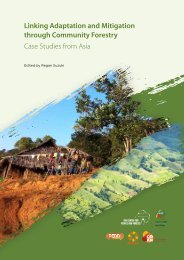Desktop Study on - Regional Climate Change Adaptation ...
Desktop Study on - Regional Climate Change Adaptation ...
Desktop Study on - Regional Climate Change Adaptation ...
Create successful ePaper yourself
Turn your PDF publications into a flip-book with our unique Google optimized e-Paper software.
<str<strong>on</strong>g>Desktop</str<strong>on</strong>g> <str<strong>on</strong>g>Study</str<strong>on</strong>g><br />
1998 El Niño/La Niña episode put the severe<br />
ec<strong>on</strong>omic impact of a total of P7.6 billi<strong>on</strong> in rice and<br />
corn producti<strong>on</strong> losses. The ENSO has impacts <strong>on</strong> all<br />
segments of society, am<strong>on</strong>g which the most affected<br />
are resource c<strong>on</strong>strained farmers whose livelihoods<br />
heavily relies <strong>on</strong> the changing seas<strong>on</strong>s. This situati<strong>on</strong><br />
is most apparent am<strong>on</strong>g rain fed farmers who are<br />
exclusively dependent <strong>on</strong> rainfall to irrigate their<br />
crops (ibid). As a c<strong>on</strong>sequence, those most affected<br />
are reinforced to suffer from poverty (World Bank,<br />
2005).<br />
A study of PCW reveals that most vulnerable areas<br />
invariably experience decline in rice producti<strong>on</strong><br />
levels from 20% to 100% (of 90-100 cavans/ha)<br />
and escalati<strong>on</strong> in producti<strong>on</strong> cost by at least 25%<br />
during periods of drought (Lasco, 2006). During<br />
floods, most of the vulnerable areas suffer between<br />
40-100% (of 60 - 90 cavans/ha) loss in producti<strong>on</strong>.<br />
It has also been found that the low yield of food<br />
grain, combined with envir<strong>on</strong>mental stresses like<br />
prol<strong>on</strong>ged dry spells and excessive rains, leads to<br />
loss of crop values. For example, Isabela had faced<br />
three c<strong>on</strong>secutive crop failures because of erratic<br />
rainfall and flooding in 2005.<br />
Some researchers observed a fall in student<br />
enrolment in the province of Albay because of the<br />
extreme events such as storm surges with floods and<br />
volcanic lahar (Resurrecci<strong>on</strong> et al., 2008). This led to<br />
rec<strong>on</strong>figuring livelihoods including increase of child<br />
labor and urban migrati<strong>on</strong>.<br />
Vulnerabilities and Adaptati<strong>on</strong> in the<br />
Socio-Ec<strong>on</strong>omic Sector<br />
Vulnerability of Areas<br />
The vulnerable places in the PCW identified by the<br />
local communities include low-lying flood-pr<strong>on</strong>e<br />
settlement areas, agricultural areas pr<strong>on</strong>e to floods<br />
and droughts, dying streams/rivers, and farmlands<br />
at the tail-end of irrigati<strong>on</strong> canal (Lasco, 2006). The<br />
interesting finding is that these places are highly<br />
c<strong>on</strong>gruent with the result of GIS-generated levels of<br />
vulnerability. Hence, the study of the PCW suggested<br />
combining the two methods for identifying the<br />
vulnerable areas as a comprehensive assessment of<br />
vulnerable areas.<br />
Vulnerability of People<br />
Am<strong>on</strong>g the differentiated socio-ec<strong>on</strong>omic groups,<br />
namely, small farmers, average farmers and<br />
fishermen, employees and small entrepreneurs, and<br />
rich farmers, the small farmers were identified as<br />
the most vulnerable by local community members<br />
(Lasco, 2006). It is to be noted that even though the<br />
climate-related losses may not be destructive at the<br />
community level, the damage climate-related losses<br />
generate to the household level could have lasting<br />
impacts and lead to a chain-reacti<strong>on</strong> of negative<br />
effects (ibid). The nature of impacts of climate<br />
variability and extremes seems to be almost the<br />
same am<strong>on</strong>g the above-menti<strong>on</strong>ed groups. However,<br />
the small farmers were identified to have the high<br />
degree of negative impacts and vulnerability due to<br />
lack of access to, or c<strong>on</strong>trol of, reproductive resources<br />
such as small land and little capital, as well as due to<br />
ineffectiveness of adaptati<strong>on</strong> strategies.<br />
The study of the PCW further examined vulnerability<br />
of people to future climate variability and extremes.<br />
The projected climate change impacts with relati<strong>on</strong><br />
to food availability and crop producti<strong>on</strong>, livelihood,<br />
health and water supply, potential adaptati<strong>on</strong><br />
strategies and the degree of vulnerability of the<br />
abovementi<strong>on</strong>ed socio-ec<strong>on</strong>omic groups were<br />
described (Lasco, 2006: 59). The degree of negative<br />
impacts and vulnerability of small farmers will<br />
exacerbate due to lack of capacity to cope with<br />
the negative impacts. For example, not <strong>on</strong>ly will<br />
their crop producti<strong>on</strong> decline, but they are likely<br />
to be exposed to starvati<strong>on</strong>, eventually resulting in<br />
malnutriti<strong>on</strong> and other kinds of health diseases.<br />
Factors influencing vulnerability were highlighted in<br />
the study of the PCW, with a focus <strong>on</strong> socio-ec<strong>on</strong>omic<br />
circumstances as well as in the socio-political and<br />
instituti<strong>on</strong>al c<strong>on</strong>texts. In terms of socio-ec<strong>on</strong>omic<br />
factors, farm income, m<strong>on</strong>thly food expenditures<br />
and farm distance to market were found significantly<br />
associated with vulnerability (Lasco, 2006). The<br />
more dependent people are <strong>on</strong> their farm income,<br />
the more vulnerable they become to climate-related<br />
events. Also, people who spend less <strong>on</strong> food due to<br />
their limited financial capacity are more vulnerable.<br />
Finally, households in far-flung areas tend to be more<br />
vulnerable because of being cut off from market<br />
during the rainy seas<strong>on</strong> and flooding. In additi<strong>on</strong><br />
to socio ec<strong>on</strong>omic factors, the socio-political and<br />
instituti<strong>on</strong>al aspects also affect vulnerability. The<br />
quality of services provided by organizati<strong>on</strong>s that<br />
the farmers join matters for reducing vulnerability.<br />
Also the larger the farm size, the more vulnerable<br />
the owners become. Furthermore, demographic<br />
research shows that women were found to be more<br />
vulnerable than men while migrants were more<br />
vulnerable than the original inhabitants.<br />
62

















